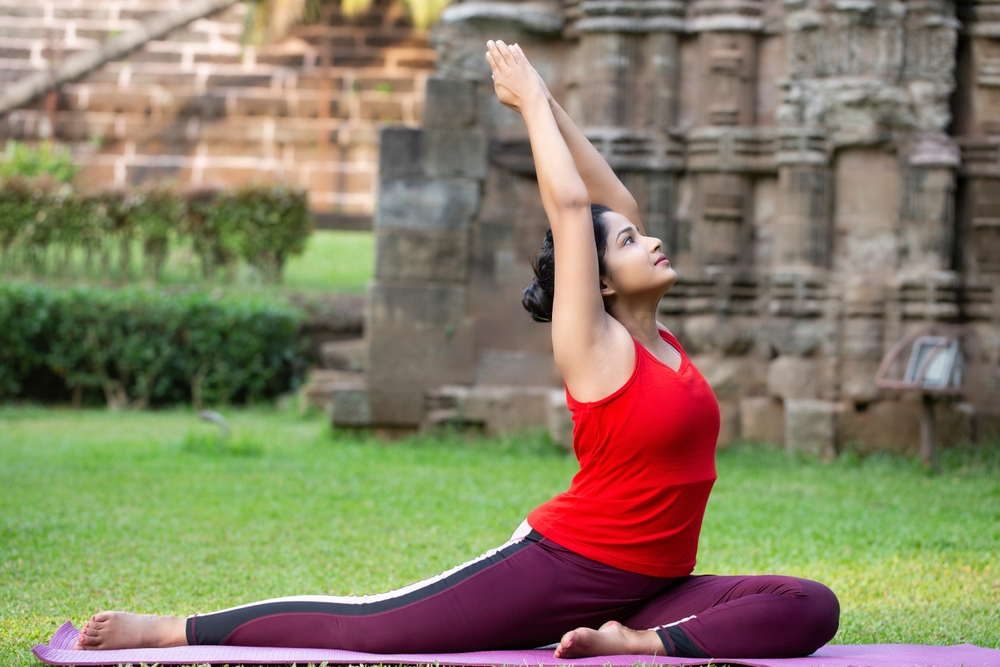Yoga isn’t necessarily every guy’s go-to form of exercise, and if you’re used to playing competitive sports, running races, lifting heavy weights in the gym, or participating in some other form of high-intensity training, yoga may not induce the same heart-pumping, vigorous workout you’ve come to associate with fitness. However, while yoga may look too slow and easy to seem worthwhile, there are actually quite a few benefits to this ancient exercise modality.
Moreover, adding yoga to your workout routine can provide a very different training stimulus and balance out the other types of exercise you do, helping you become a more injury-resilient, well-rounded athlete. So, root around in your closet to unearth your forgotten yoga mat, or lay down a big towel, and get ready to learn about the benefits of yoga and how to get started with yoga today.
Benefits of Yoga
The beginnings of yoga as a practice span over 5,000 years. Today, various forms of yoga are practiced and adored all over the world, and with good reason: it has many benefits. Most people immediately think of the improvements in flexibility and balance, but the benefits of yoga go far beyond making your body more limber. Research has demonstrated that a consistent yoga practice affords a host of physical, emotional, and mental benefits, including the following:
1. Yoga Can Decrease Stress
One of the primary reasons many yoga fanatics are initially drawn to the practice is for the stress-relieving benefits of yoga. In fact, most people cite feeling immediate stress relief after even just a few yoga poses or a single session of yoga. Yoga decreases the production of cortisol, a key stress hormone, and increases mindfulness and a sense of inner peace, both of which alleviate stress and help you feel calmer.
2. Yoga Can Help Manage Anxiety
While it’s not entirely clear exactly how yoga can help people manage anxiety, there’s quite an extensive body of research demonstrating the ability of a consistent yoga practice to reduce anxiety and even symptoms of PTSD. The emphasis on mindfulness, being present, and honing in on the awareness of your breath may contribute to finding a sense of peace.
3. Yoga Can Improve Your Mood and Mitigate Depression
Any form of exercise can produce endorphins and increase mood. Yoga has been studied extensively, and seems particularly effective at alleviating depression, and improving outlook and overall sense of wellbeing. The anti-depressant effect of yoga is due to the fact that yoga decreases the level of cortisol in the body, which is a stress hormone that can inhibit levels of serotonin. Serotonin is a neurotransmitter that elevates mood and improves your sense of wellbeing, so by lowering cortisol, yoga enables the body to produce more serotonin to feel better.
4. Yoga Can Improve Muscular Strength.
If you’ve ever gotten into tree pose and felt your leg shaking, or felt your abs quivering in plank position as the seconds tick by, you’re familiar with the fact that yoga can definitely work your muscles. Yoga poses often look deceptively easy, but they can require quite a bit of core strength as well as upper body and leg strength. Each yoga pose represents an isometric muscle contraction — holding statically without moving — while stringing poses together in a yoga sequence or yoga flow also involves concentric and eccentric contractions.
5. Yoga Can Improve Sleep Quality
Sleep problems are widespread, with many people struggling to fall asleep, stay asleep, or get enough sleep every night. In addition to eating foods to support sleep, getting the most comfortable mattress possible, using a weighted blanket, and throwing in some sleep earbuds to create a quiet sleeping sanctuary, you can practice calming yoga poses before bed to promote healthy sleep. Research has found that yoga can increase the production of melatonin, a hormone that regulates the sleep-wake cycle, and people who practice yoga consistently report better more restorative sleep.
6. Yoga Can Reduce Chronic Pain
Chronic pain affects millions of adults and can be anything from recurrent migraines to osteoarthritis in the knees or hips. Yoga has been found to reduce symptoms in nearly every specific chronic pain condition and population studied, from low back pain sufferers to those with rheumatoid arthritis, carpal tunnel syndrome, or fibromyalgia.
7. Yoga Can Support the Immune System and Improve Overall Health
There is some research to show that yoga may help support the immune system, improve respiratory function, and reduce the severity of asthma and allergies. Yoga has also been shown to reduce inflammation, which can help manage pain and overall wellness, as chronic inflammation is a risk factor for many chronic diseases, including cardiovascular disease, diabetes, obesity, and certain cancers. Poses are thought to increase lymphatic circulation, which can help support the immune system. Focusing on deep breathing also strengthens the diaphragm and deep core muscles to improve respiratory function.
8. Yoga Enhances the Mind-body Connection
By focusing on your breath and finding your center, connecting movements to breathing, and quieting out external distractions, and being present, yoga strengthens the mind-body connection and helps bring awareness to where your body is in space, how your body feels and reacts to your mind, and how you can influence how you feel in your mind and body by manipulating each one separately and together.
9. Yoga Increases Mobility
We tend to lose mobility of our joints and muscles as we age. The flexibility work in yoga helps prevent this decline and keeps us feeling more youthful. Yoga poses increase the range of motion of joints, improve spinal mobility and flexibility, and reduce pain associated with stiffness.
10. Yoga Increases Flexibility and Balance of the Body and Mind
Flexibility and balance in yoga extend beyond the physical poses and positions of your body on the mat. Yoga emphasizes flexibility and balance of the mind as well, teaching you to be more open-minded, adaptable, present, gentle on yourself, and emotionally open and connected. This may sound somewhat airy-fairy, but many people who take up yoga report that while they initially felt somewhat turned off or intimidated by the spiritual/emotional side of yoga, they now appreciate that aspect of the discipline nearly as much (if not more) than the physical work itself.
How to Get Started With Yoga
You don’t have to have yoga blocks, straps, and other props to get started, though a good yoga mat will help. You can use a towel instead, though a yoga mat provides a more grippy surface, so it is safer and may make holding static poses easier. See if there are any beginner classes at your gym or local yoga studio, or look for free yoga workout videos online. It’s important to start with fairly basic poses and listen to your body as you hold a pose, without overreaching or pushing behind comfort.






